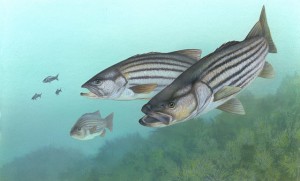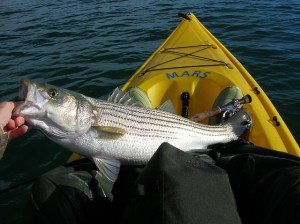Striped Bass, or rockfish, are one of the most popular game fish in the U.S. and with good reason. An adult striper can routinely tip the scales at 15-20 pounds and it is not usual to hook monsters topping 30 pounds or more, especially during the spring migration. The world record, caught in Connecticut, weighs a jaw-dropping 81 pounds 14 ounces! Many anglers mistakenly believe that chasing this silver trophy requires years of knowledge, massive amounts of equipment and access to secret honey holes. While all of this helps, it is not necessary. With a little knowledge, some basic equipment and the ability to reach one of the migratory routes almost anyone can learn to land this king of game fish.
The Striped Bass
 Striped bass are members of the temperate bass family; more closely related to sea bass and white perch than their cousins the largemouth. Stripers can be easily identified by their designative dark lateral stripes, smooth rounded profile, and coloration that include a dark olive green back, silver sides, and white belly. Like other members of the temperate bass family the striper has two dorsal fins; a spiked front fin and a soft rear fin, separated by a notch. They are also anadromous, meaning they spend the majority of their life in the salt water but return to coastal rivers for the annual spawn.
Striped bass are members of the temperate bass family; more closely related to sea bass and white perch than their cousins the largemouth. Stripers can be easily identified by their designative dark lateral stripes, smooth rounded profile, and coloration that include a dark olive green back, silver sides, and white belly. Like other members of the temperate bass family the striper has two dorsal fins; a spiked front fin and a soft rear fin, separated by a notch. They are also anadromous, meaning they spend the majority of their life in the salt water but return to coastal rivers for the annual spawn.
Although stripers can be targeted at any time during their travels, it is when they make the annual migration during which they are more easily located. For this reason, I recommend beginners start adventure during this phase of the journey. While migrating the fish congregate in large schools, feeding hungrily and can be easily accessed from shore or small boats – the perfect combination for novice success.
Striper Fishing Gear
 Striper anglers, not unlike those targeting any particular species, utilize a vast array of rods, reels, and tackle. From the top of the line surf gear to specialized saltwater fly tackle and everything in between can be found on the water when the call goes out “stripers are running.” Trying to determine what you should have can be challenging and enough to keep the newbie from even giving it a try. But in reality, most anglers already have, or can easily acquire, what they need to get started.
Striper anglers, not unlike those targeting any particular species, utilize a vast array of rods, reels, and tackle. From the top of the line surf gear to specialized saltwater fly tackle and everything in between can be found on the water when the call goes out “stripers are running.” Trying to determine what you should have can be challenging and enough to keep the newbie from even giving it a try. But in reality, most anglers already have, or can easily acquire, what they need to get started.
For shore fishing, you will need a sturdy medium -heavy rod coupled with a reel capable of handling 12 to 20 pound test line. Lighter gear will work, especially when targeting schoolies, or younger fish, but will not handle the monster cows you want. I also recommend beginners select a quality spinning reel as they are easier to use than bait casters and allow more flexibility regarding use with baits, lures, and artificials. A six or seven foot rod with a Penn spinning reel, fifteen pound line makes a perfect starter kit.
Locating Stripers
As stated earlier, striped bass spend the majority of their year in the coastal waters and can be found from Maine to Florida, with the majority of fish observed between the Carolinas and Massachusetts. A small west coast population can also be found in the San Francisco Bay Area. As the river ocean temperatures begin to rise the fish will move towards the mouths of nearby rivers and wait. This marks for a perfect time to target them from fishing piers, jetties or even the beach as many of the fish will feed aggressively in anticipation of the energy draining journey they are about to begin.
The schools will continue to grow, feed and wait until the river temperatures reach approximately 50 degrees when they start heading upstream. Like those waiting offshore, the migrating stripers will be excellent targets for anglers waiting along the shoreline as they move, feed and spawn. Schools of fish will repeatedly stop as they head upstream, usually to feed or again wait for ideal conditions, and often grow to several size their original number as several schools join. While this offers once a season opportunities it also does not last long as the fish will soon be on their way again.
Once the fish have arrived, you need to narrow your search area. The first place to look is near rocks, a favorite hiding place for not only the striped bass but also the baitfish they feed upon (they’re not nicknamed “rockfish” for nothing). Off jetties or around bridge supports or piers should all be on your radar. Next, look for ledges, channels or other underwater drops that may provide the fish a hiding place from which to ambush future meals. Finally, hit the tidal flats. Look for flats that are located near the mouth of tributaries with a depth of between three to six feet and fish them during an outgoing or slack tide. The bait fish from the nearby waterway will swarm the area and signal “dinner time!” to any hungry stripers in the area.
Striper Bait & Lures
The final question is “What bait or lure to use”? Depending upon the local water migrating striped bass will feed on a wide variety of wild baitfish including eels, herring, alewife, and shad. Whether you are using live or cut bait, it is always better to select something that is found locally, the same as when fly fishermen “match the hatch.” If live bait is not available bloodworms, clams or cut bait are all excellent options. A size 1/0 circle hook is a perfect method of not only presenting your bait but also increasing the possibility of practicing catch and release.
If you prefer to use lures do not worry, they can be equally successful and a lot of fun when hit by vicious, hungry twenty pounders. When the water surface is choppy or rough, I prefer to go underwater, with a rubber artificial / bucktail combination or suspending jerk bait. If fishing a smooth as glass surface, especially during a full moon and high tide, nothing beats a giant striper hitting a slow moving plug or chugger as it threatens to pull the rod from your hands.
